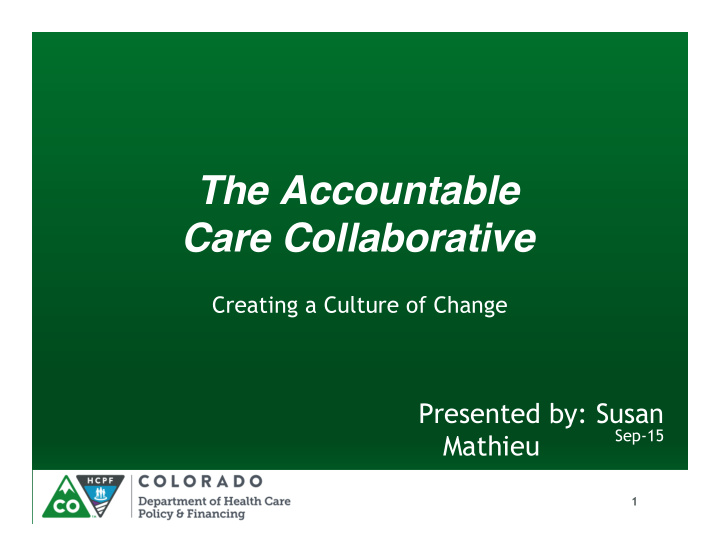



The Accountable Care Collaborative � Creating a Culture of Change Presented by: Susan Sep-15 Mathieu 1
What is the Accountable Care Collaborative (ACC) Program? https://www.youtube.com/watch?v=1GasHG7v9eI 2
Created in response to: § Unsuccessful attempt at capitated Managed Care in the state § 85% in an unmanaged Fee-For- Service (FFS) system § Highest caseload and expenditures in the state’s history of Medicaid
ACC Approach • Not traditional managed care • Offers the full benefits of Medicaid • Connects members to medical and non-medical (social) services to support health • Coordinated care and, ultimately, integrated care at the regional level
Strategies • Every member has a Primary Care Medical Provider (PCMP) • All ACC members and PCMPs belong to a local Regional Care Collaborative Organization (RCCO) • Unprecedented access to data from the Statewide Data and Analytics Contractor (SDAC) • Gradual introduction of payment strategies to reward outcomes instead of volume
ACC Components Statewide Data and Analytics Contractor (SDAC) Regional Care Primary Care Collaborative Medical Organizations Providers (RCCOs) (PCMPs) 6
ACC Components Statewide Data and Analytics Contractor (SDAC) Regional Care Primary Care Collaborative Medical Organizations Providers (RCCOs) (PCMPs) 7
RCCOs • Ensure a medical home for every member • Develop and manage a network • Support providers • Ensure medical management and care coordination • Report on progress and outcomes • Accountable for health outcomes and costs
Seven RCCOs RCCO 2 RCCO 6 RCCO 5 RCCO 3 RCCO 1 RCCO 7 RCCO 4
RCCO Payment Model • Per-member-per-month payment (PMPM) • Incentive payment for meeting Key Performance measures (KPI) • Potential for shared savings • May delegate care coordination duties to providers
ACC Components Statewide Data and Analytics Contractor (SDAC) Regional Care Primary Care Collaborative Medical Organizations Providers (RCCOs) (PCMPs) 11
PCMPs • Serve as client-centered medical homes • Provide accessible, comprehensive primary care • Coordinate medical care • Educate clients to promote self- management • Contract with the State and an individual RCCO
Benefits for Providers: Payment • Per-member-per-month payment (PMPM) • Continued fee-for-service reimbursement • Incentive payments • Extra PMPM for meeting certain factors • Potential for shared savings
Other Benefits for Providers • Help with navigating payment and administrative hurdles • Practice support & coaching • Care coordination, non-medical resource and other support for your patients • Access to SDAC: patient & panel data • Set limits on patient panels
ACC Components Statewide Data and Analytics Contractor (SDAC) Regional Care Primary Care Collaborative Medical Organizations Providers (RCCOs) (PCMPs) 15
SDAC • Compile data from claims and other sources • Track and report on trends in service utilization • Provide data for accountability and continuous improvement • Make data available to RCCOs and PCMPs
How the ACC Works for Clients • Passive enrollment • Attributed to PCMP by claims history, if possible • Family connection • Client choice
How the ACC Works for Clients • Care management, navigation support from RCCOs • Access to education and special programs • Non-medical community resources
Accountable Care Collaborative Our Mission: Improving health care access � and outcomes for the people � we serve while demonstrating sound stewardship of financial resources �
Evolution of the ACC Move away from volume-based, FFS model toward value-based payment that supports whole-person, integrated care. 20
Year 3 Year 1 Year 2 Year 4… • Build medical networks, recruit PCMPs • Higher PMPM for enhanced PCMP status • PRIME program • ACC: MMP program • Further integration of behavioral health • Higher PMPM, less $$ at risk • RCCO bonus based on performance • Lower PMPM • More PMPM at risk, attribution • Colorado Opportunity Project • KPIs emphasized savings • Post DC follow-up linked to shared savings • Well-child KPI added • New KPIs focus on postpartum, WC 3-9 • Non-medical resources 21
Value of the ACC • Better, more coordinated and appropriate care • Supports self-management • Fewer expensive services like ER visits, hospital stays and unnecessary tests • Builds local health care infrastructure
Value of the ACC • Clients > 6 months in the ACC • ER visits decreased for adults (21%) and children (2%) • High cost imaging services were significantly lower for adults (35%) and children (19%) • 30-day, all cause hospital readmissions were 33% lower for both adults and children
Value of the ACC § ACC clients, since 2012: • Children with disabilities: • 6% increase in the number of professional care visits • 7% decrease in ER visits • Children with asthma • 16% decrease in the number of preventable services
Value of the ACC § ACC clients, since 2012: • Adults with disabilities • 29% decrease in 30-day, all cause hospital readmissions • Adults with diabetes • 7% increase in the number of professional visits
ACC Version 2.0 The next version of the ACC seeks to optimize health for those served by Medicaid through accountability for value and client experience at every life stage. 26
Re-procurement Timeline 27
ACC v2.0 – Policy Decisions as announced in April, 2015 • One administrative entity per region • Combines responsibilities of RCCOs and BHOs • Payment • Regional map 28
ACC Investment and Returns For FY 2013-2014: • Administrative costs: just over $69 million – Per-member-per-month payments – Incentive payments and SDAC contract • Gross savings of about $98 million in medical spending; net savings of about $30 million • Added value: stronger local health care systems
Questions or Concerns? 30
Contact Information Susan Mathieu ACC Program Manager Susan.Mathieu@state.co.us 31
Thank You! 32
Recommend
More recommend